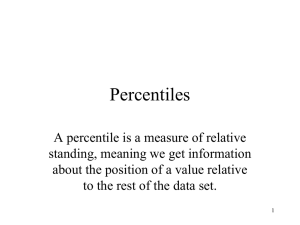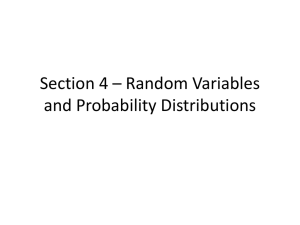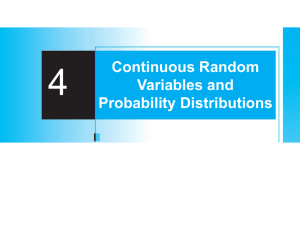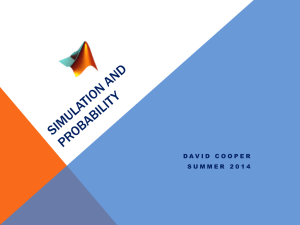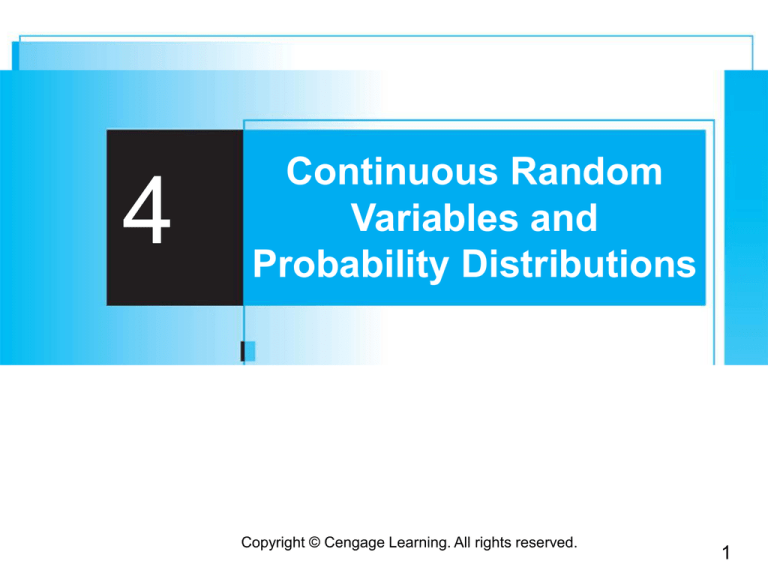
4
Continuous Random
Variables and
Probability Distributions
Copyright © Cengage Learning. All rights reserved.
1
Probability Density Functions
Recall from Chapter 3 that a random variable X is
continuous if
(1) possible values comprise either a single interval on the
number line (for some A < B, any number x between A
and B is a possible value) or a union of disjoint intervals,
and
(2) P(X = c) = 0 for any number c that is a possible value of
X.
2
Probability Distributions for Continuous Variables
Suppose the variable X of interest is the depth of a lake at
a randomly chosen point on the surface.
Let M = the maximum depth (in meters), so that any
number in the interval [0, M] is a possible value of X.
If we “discretize” X by measuring depth to the nearest
meter, then possible values are nonnegative integers less
than or equal to M.
The resulting discrete distribution of depth can be pictured
using a probability histogram.
3
Probability Distributions for Continuous Variables
If we draw the histogram so that the area of the rectangle
above any possible integer k is the proportion of the lake
whose depth is (to the nearest meter) k, then the total area
of all rectangles is 1. A possible histogram appears in
Figure 4.1(a).
Probability histogram of depth measured to the nearest meter
Figure 4.1(a)
4
Probability Distributions for Continuous Variables
If depth is measured much more accurately and the same
measurement axis as in Figure 4.1(a) is used, each
rectangle in the resulting probability histogram is much
narrower, though the total area of all rectangles is still 1. A
possible histogram is pictured in Figure 4.1(b).
Probability histogram of depth measured to the nearest centimeter
Figure 4.1(b)
5
Probability Distributions for Continuous Variables
It has a much smoother appearance than the histogram in
Figure 4.1(a). If we continue in this way to measure depth
more and more finely, the resulting sequence of histograms
approaches a smooth curve, such as is pictured in Figure
4.1(c).
A limit of a sequence of discrete histograms
Figure 4.1(c)
6
Probability Distributions for Continuous Variables
Because for each histogram the total area of all rectangles
equals 1, the total area under the smooth curve is also 1.
The probability that the depth at a randomly chosen point is
between a and b is just the area under the smooth curve
between a and b. It is exactly a smooth curve of the type
pictured in Figure 4.1(c) that specifies a continuous
probability distribution.
7
Probability Distributions for Continuous Variables
Definition
Let X be a continuous rv. Then a probability distribution
or probability density function (pdf) of X is a function f(x)
such that for any two numbers a and b with a b,
P(a X b) =
8
Probability Distributions for Continuous Variables
That is, the probability that X takes on a value in the
interval [a, b] is the area above this interval and under the
graph of the density function, as illustrated in Figure 4.2.
P(a X b) = the area under the density curve between a and b
Figure 4.2
The graph of f(x) is often referred to as the density curve.
9
Probability Distributions for Continuous Variables
For f(x) to be a legitimate pdf, it must satisfy the following
two conditions:
1. f(x) 0 for all x
2.
= area under the entire graph of f(x)
=1
10
Probability Distributions for Continuous Variables
Definition
A continuous rv X is said to have a uniform distribution
on the interval [A, B] if the pdf of X is
11
Probability Distributions for Continuous Variables
The fact that P(X = c) = 0 when X is continuous has an
important practical consequence: The probability that X lies
in some interval between a and b does not depend on
whether the lower limit a or the upper limit b is included in
the probability calculation:
P(a X b) = P(a < X < b) = P(a < X b) = P(a X < b)
(4.1)
If X is discrete and both a and b are possible values (e.g., X
is binomial with n = 20 and a = 5, b = 10), then all four of
the probabilities in (4.1) are different.
12
Probability Distributions for Continuous Variables
Unlike discrete distributions such as the binomial,
hypergeometric, and negative binomial, the distribution of
any given continuous rv cannot usually be derived using
simple probabilistic arguments.
Just as in the discrete case, it is often helpful to think of the
population of interest as consisting of X values rather than
individuals or objects.
The pdf is then a model for the distribution of values in this
numerical population, and from this model various
population characteristics (such as the mean) can be
calculated.
13
The Cumulative Distribution Function
The cumulative distribution function (cdf) F(x) for a discrete
rv X gives, for any specified number x, the probability
P(X x) .
It is obtained by summing the pmf p(y) over all possible
values y satisfying y x.
The cdf of a continuous rv gives the same probabilities
P(X x) and is obtained by integrating the pdf f(y) between
the limits
and x.
14
The Cumulative Distribution Function
Definition
The cumulative distribution function F(x) for a
continuous rv X is defined for every number x by
F(x) = P(X x) =
For each x, F(x) is the area under the density curve to the
left of x. This is illustrated in Figure 4.5, where F(x)
increases smoothly as x increases.
A pdf and associated cdf
Figure 4.5
15
Let X have a uniform distribution on [A, B].
The density function is shown in Figure 4.6.
The pdf for a uniform distribution
Figure 4.6
16
cont’d
For x < A, F(x) = 0, since there is no area under the graph
of the density function to the left of such an x.
For x B, F(x) = 1, since all the area is accumulated to the
left of such an x. Finally for A x B,
17
cont’d
The entire cdf is
The graph of this cdf appears in Figure 4.7.
The cdf for a uniform distribution
Figure 4.7
18
Using F(x) to Compute Probabilities
The importance of the cdf here, just as for discrete rv’s, is
that probabilities of various intervals can be computed from
a formula for or table of F(x).
Proposition
Let X be a continuous rv with pdf f(x) and cdf F(x). Then for
any number a,
P(X > a) = 1 – F(a)
and for any two numbers a and b with a < b,
P(a X b) = F(b) – F(a)
19
Obtaining f(x) from F(x)
For X discrete, the pmf is obtained from the cdf by taking
the difference between two F(x) values. The continuous
analog of a difference is a derivative.
The following result is a consequence of the Fundamental
Theorem of Calculus.
Proposition
If X is a continuous rv with pdf f(x) and cdf F(x), then at
every x at which the derivative F(x) exists, F(x) = f(x).
20
When X has a uniform distribution, F(x) is differentiable
except at x = A and x = B, where the graph of F(x) has
sharp corners.
Since F(x) = 0 for x < A and F(x) = 1 for
x > B, F(x) = 0 = f(x) for such x.
For A < x < B,
21
Percentiles of a Continuous Distribution
When we say that an individual’s test score was at the 85th
percentile of the population, we mean that 85% of all
population scores were below that score and 15% were
above.
Similarly, the 40th percentile is the score that exceeds 40%
of all scores and is exceeded by 60% of all scores.
22
Percentiles of a Continuous Distribution
Proposition
Let p be a number between 0 and 1. The (100p)th
percentile of the distribution of a continuous rv X, denoted
by (p), is defined by
p = F((p)) =
F(y) dy
(4.2)
According to Expression (4.2), (p) is that value on the
measurement axis such that 100p% of the area under the
graph of f(x) lies to the left of (p) and 100(1 – p)% lies to
the right.
23
Percentiles of a Continuous Distribution
Thus (.75), the 75th percentile, is such that the area under
the graph of f(x) to the left of (.75) is .75.
Figure 4.10 illustrates the definition.
The (100p)th percentile of a continuous distribution
Figure 4.10
24
Percentiles of a Continuous Distribution
Definition
The median of a continuous distribution, denoted by , is
the 50th percentile, so satisfies .5 = F( ) That is, half the
area under the density curve is to the left of and half is to
the right of .
A continuous distribution whose pdf is symmetric—the
graph of the pdf to the left of some point is a mirror image
of the graph to the right of that point—has median equal
to the point of symmetry, since half the area under the
curve lies to either side of this point.
25
Percentiles of a Continuous Distribution
Figure 4.12 gives several examples. The error in a
measurement of a physical quantity is often assumed to
have a symmetric distribution.
Medians of symmetric distributions
Figure 4.12
26
Expected Values
For a discrete random variable X, E(X) was obtained by
summing x p(x)over possible X values.
Here we replace summation by integration and the pmf by
the pdf to get a continuous weighted average.
Definition
The expected or mean value of a continuous rvX with
pdf f(x) is
x = E(X) =
x f(x) dy
27
Expected Values
When the pdf f(x) specifies a model for the distribution of
values in a numerical population, then is the population
mean, which is the most frequently used measure of
population location or center.
Often we wish to compute the expected value of some
function h(X) of the rv X.
If we think of h(X) as a new rv Y, techniques from
mathematical statistics can be used to derive the pdf of Y,
and E(Y) can then be computed from the definition.
28
Expected Values
Fortunately, as in the discrete case, there is an easier way
to compute E[h(X)].
Proposition
If X is a continuous rv with pdf f(x) and h(X) is any function
of X, then
E[h(X)] = h(X) =
h(x) f (x) dx
29
Expected Values
For h(X), a linear function, E[h(X)] = E(aX + b) = aE(X) + b.
In the discrete case, the variance of X was defined as the
expected squared deviation from and was calculated by
summation. Here again integration replaces summation.
Definition
The variance of a continuous random variable X with pdf
f(x) and mean value is
= V(X) =
(x – )2 f(x)dx = E[(X – )2]
The standard deviation (SD) of X is X =
30
Expected Values
The variance and standard deviation give quantitative
measures of how much spread there is in the distribution or
population of x values.
Again is roughly the size of a typical deviation from .
Computation of 2 is facilitated by using the same shortcut
formula employed in the discrete case.
Proposition
V(X) = E(X2) – [E(X)]2
31
cont’d
When h(X) = aX + b, the expected value and variance of
h(X) satisfy the same properties as in the discrete case:
E[h(X)] = a + b and V[h(X)] = a2 2.
32
The Normal Distribution
The normal distribution is the most important one in all of
probability and statistics. Many numerical populations have
distributions that can be fit very closely by an appropriate
normal curve.
Examples include heights, weights, and other physical
characteristics (the famous 1903 Biometrika article “On the
Laws of Inheritance in Man” discussed many examples of
this sort), measurement errors in scientific experiments,
anthropometric measurements on fossils, reaction times in
psychological experiments, measurements of intelligence
and aptitude, scores on various tests, and numerous
economic measures and indicators.
33
The Normal Distribution
Definition
A continuous rv X is said to have a normal distribution
with parameters and (or and 2), where
<<
and 0 < , if the pdf of X is
f(x; , ) =
<x<
(4.3)
Again e denotes the base of the natural logarithm system
and equals approximately 2.71828, and represents the
familiar mathematical constant with approximate value
3.14159.
34
The Normal Distribution
The statement that X is normally distributed with
parameters and 2 is often abbreviated X ~ N(, 2).
Clearly f(x; , ) 0, but a somewhat complicated calculus
argument must be used to verify that
f(x; , ) dx = 1.
It can be shown that E(X) = and V(X) = 2, so the
parameters are the mean and the standard deviation of X.
35
The Normal Distribution
Figure 4.13 presents graphs of f(x; , ) for several
different (, ) pairs.
Two different normal density curves
Figure 4.13(a)
Visualizing and for a normal
distribution
Figure 4.13(b)
36
The Normal Distribution
Each density curve is symmetric about and bell-shaped,
so the center of the bell (point of symmetry) is both the
mean of the distribution and the median.
The value of is the distance from to the inflection points
of the curve (the points at which the curve changes from
turning downward to turning upward).
37
The Normal Distribution
Large values of yield graphs that are quite spread out
about , whereas small values of yield graphs with a high
peak above and most of the area under the graph quite
close to .
Thus a large implies that a value of X far from may well
be observed, whereas such a value is quite unlikely when
is small.
38
The Standard Normal Distribution
The computation of P(a X b) when X is a normal rv with
parameters and requires evaluating
(4.4)
None of the standard integration techniques can be used to
accomplish this. Instead, for = 0 and = 1, Expression
(4.4) has been calculated using numerical techniques
and tabulated for certain values of a and b.
This table can also be used to compute probabilities for any
other values of and under consideration.
39
The Standard Normal Distribution
Definition
The normal distribution with parameter values = 0 and
= 1 is called the standard normal distribution.
A random variable having a standard normal distribution is
called a standard normal random variable and will be
denoted by Z. The pdf of Z is
<z<
The graph of f(z; 0, 1) is called the standard normal (or z)
curve. Its inflection points are at 1 and –1. The cdf of Z is
P(Z z) =
which we will denote by
40
The Standard Normal Distribution
The standard normal distribution almost never serves as a
model for a naturally arising population.
Instead, it is a reference distribution from which information
about other normal distributions can be obtained.
Appendix Table A.3 gives
= P(Z z), the area under the
standard normal density curve to the left of z, for
z = –3.49, –3.48,..., 3.48, 3.49.
41
The Standard Normal Distribution
Figure 4.14 illustrates the type of cumulative area
(probability) tabulated in Table A.3. From this table, various
other probabilities involving Z can be calculated.
Standard normal cumulative areas tabulated in Appendix Table A.3
Figure 4.14
42
Percentiles of the Standard Normal Distribution
For any p between 0 and 1, Appendix Table A.3 can be
used to obtain the (100p)th percentile of the standard
normal distribution.
43
The 99th percentile of the standard normal distribution is
that value on the horizontal axis such that the area under
the z curve to the left of the value is .9900.
Appendix Table A.3 gives for fixed z the area under the
standard normal curve to the left of z, whereas here we
have the area and want the value of z. This is the “inverse”
problem to P(Z z) = ?
so the table is used in an inverse fashion: Find in the
middle of the table .9900; the row and column in which it
lies identify the 99th z percentile.
44
cont’d
Here .9901 lies at the intersection of the row marked 2.3
and column marked .03, so the 99th percentile is
(approximately) z = 2.33.
(See Figure 4.17.)
Finding the 99th percentile
Figure 4.17
45
cont’d
By symmetry, the first percentile is as far below 0 as the
99th is above 0, so equals –2.33 (1% lies below the first
and also above the 99th).
(See Figure 4.18.)
The relationship between the 1st and 99th percentiles
Figure 4.18
46
Percentiles of the Standard Normal Distribution
In general, the (100p)th percentile is identified by the row
and column of Appendix Table A.3 in which the entry p is
found (e.g., the 67th percentile is obtained by finding .6700
in the body of the table, which gives z = .44).
If p does not appear, the number closest to it is often used,
although linear interpolation gives a more accurate answer.
47
Percentiles of the Standard Normal Distribution
For example, to find the 95th percentile, we look for .9500
inside the table.
Although .9500 does not appear, both .9495 and .9505 do,
corresponding to z = 1.64 and 1.65, respectively.
Since .9500 is halfway between the two probabilities that
do appear, we will use 1.645 as the 95th percentile and
–1.645 as the 5th percentile.
48
z Notation for z Critical Values
In statistical inference, we will need the values on the
horizontal z axis that capture certain small tail areas under
the standard normal curve.
Notation
z will denote the value on the z axis for which of the
area under the z curve lies to the right of z.
(See Figure 4.19.)
z notation Illustrated
Figure 4.19
49
z Notation for z Critical Values
Table 4.1 lists the most useful z percentiles and z values.
Standard Normal Percentiles and Critical Values
Table 4.1
50
Nonstandard Normal Distributions
When X ~ N(, 2), probabilities involving X are computed
by “standardizing.” The standardized variable is (X – )/.
Subtracting shifts the mean from to zero, and then
dividing by scales the variable so that the standard
deviation is 1 rather than .
Proposition
If X has a normal distribution with mean and standard
deviation , then
51
Nonstandard Normal Distributions
has a standard normal distribution. Thus
52
Nonstandard Normal Distributions
The key idea of the proposition is that by standardizing, any
probability involving X can be expressed as a probability
involving a standard normal rv Z, so that Appendix Table
A.3 can be used.
This is illustrated in Figure 4.21.
Equality of nonstandard and standard normal curve areas
Figure 4.21
53
Nonstandard Normal Distributions
The proposition can be proved by writing the cdf of
Z = (X – )/ as
Using a result from calculus, this integral can be
differentiated with respect to z to yield the desired pdf
f(z; 0, 1).
54
Percentiles of an Arbitrary Normal Distribution
The (100p)th percentile of a normal distribution with mean
and standard deviation is easily related to the (100p)th
percentile of the standard normal distribution.
Proposition
Another way of saying this is that if z is the desired
percentile for the standard normal distribution, then the
desired percentile for the normal (, ) distribution is z
standard deviations from .
55
The Exponential Distributions
The family of exponential distributions provides probability
models that are very widely used in engineering and
science disciplines.
Definition
X is said to have an exponential distribution with
parameter ( > 0) if the pdf of X is
(4.5)
56
The Exponential Distributions
Some sources write the exponential pdf in the form
so that = 1/ . The expected value of an exponentially
distributed random variable X is
,
Obtaining this expected value necessitates doing an
integration by parts. The variance of X can be computed
using the fact that V(X) = E(X2) – [E(X)]2.
The determination of E(X2) requires integrating by parts
twice in succession.
57
The Exponential Distributions
The results of these integrations are as follows:
Both the mean and standard deviation of the exponential
distribution equal 1/.
Graphs of several exponential
pdf’s are illustrated in Figure 4.26.
Exponential density curves
Figure 4.26
58
The Exponential Distributions
The exponential pdf is easily integrated to obtain the cdf.
59
The Exponential Distributions
The exponential distribution is frequently used as a model
for the distribution of times between the occurrence of
successive events, such as customers arriving at a service
facility or calls coming in to a switchboard.
60
The Exponential Distributions
Another important application of the exponential distribution
is to model the distribution of component lifetime.
A partial reason for the popularity of such applications is
the “memoryless” property of the exponential
distribution.
Suppose component lifetime is exponentially distributed
with parameter .
61
The Exponential Distributions
After putting the component into service, we leave for a
period of t0 hours and then return to find the component
still working; what now is the probability that it lasts at least
an additional t hours?
In symbols, we wish P(X t + t0 | X t0).
By the definition of conditional probability,
62
The Exponential Distributions
But the event X t0 in the numerator is redundant, since
both events can occur if X t + t0 and only if. Therefore,
This conditional probability is identical to the original
probability P(X t) that the component lasted t hours.
63
The Exponential Distributions
Thus the distribution of additional lifetime is exactly the
same as the original distribution of lifetime, so at each point
in time the component shows no effect of wear.
In other words, the distribution of remaining lifetime is
independent of current age.
64
The Exponential Distributions
Proposition
Suppose that the number of events occurring in any time
interval of length t has a Poisson distribution with
parameter t (where , the rate of the event process, is the
expected number of events occurring in 1 unit of time) and
that numbers of occurrences in nonoverlapping intervals
are independent of one another. Then the distribution of
elapsed time between the occurrence of two successive
events is exponential with parameter = .
65
The Exponential Distributions
Although a complete proof is beyond the scope of the text,
the result is easily verified for the time X1 until the first
event occurs:
P(X1 t) = 1 – P(X1 > t) = 1 – P [no events in (0, t)]
which is exactly the cdf of the exponential distribution.
66
The Lognormal Distribution
Definition
A nonnegative rv X is said to have a lognormal
distribution if the rv Y = ln(X) has a normal distribution.
The resulting pdf of a lognormal rv when ln(X) is normally
distributed with parameters and is
67
The Lognormal Distribution
Be careful here; the parameters and are not the mean
and standard deviation of X but of ln(X).
It is common to refer to and as the location and the
scale parameters, respectively. The mean and variance of
X can be shown to be
In Chapter 5, we will present a theoretical justification for
this distribution in connection with the Central Limit
Theorem, but as with other distributions, the lognormal can
be used as a model even in the absence of such
justification.
68
The Lognormal Distribution
Figure 4.30 illustrates graphs of the lognormal pdf;
although a normal curve is symmetric, a lognormal curve
has a positive skew.
Lognormal density curves
Figure 4.30
69
The Lognormal Distribution
Because ln(X) has a normal distribution, the cdf of X can be
expressed in terms of the cdf (z) of a standard normal
rv Z.
F(x; , ) = P(X x) = P[ln(X) ln(x)]
(4.13)
70
Probability Plots
An investigator will often have obtained a numerical sample
x1, x2,…, xn and wish to know whether it is plausible that it
came from a population distribution of some particular type
(e.g., from a normal distribution).
For one thing, many formal procedures from statistical
inference are based on the assumption that the population
distribution is of a specified type. The use of such a
procedure is inappropriate if the actual underlying
probability distribution differs greatly from the assumed
type.
71
Probability Plots
For example, the article “Toothpaste Detergents: A
Potential Source of Oral Soft Tissue Damage” (Intl. J. of
Dental Hygiene, 2008: 193–198) contains the following
statement:
“Because the sample number for each experiment
(replication) was limited to three wells per treatment type,
the data were assumed to be normally distributed.”
72
Probability Plots
As justification for this leap of faith, the authors wrote that
“Descriptive statistics showed standard deviations that
suggested a normal distribution to be highly likely.” Note:
This argument is not very persuasive.
Additionally, understanding the underlying distribution can
sometimes give insight into the physical mechanisms
involved in generating the data. An effective way to check a
distributional assumption is to construct what is called a
probability plot.
73
Probability Plots
The essence of such a plot is that if the distribution on
which the plot is based is correct, the points in the plot
should fall close to a straight line.
If the actual distribution is quite different from the one used
to construct the plot, the points will likely depart
substantially from a linear pattern.
74
Sample Percentiles
The details involved in constructing probability plots differ a
bit from source to source. The basis for our construction is
a comparison between percentiles of the sample data and
the corresponding percentiles of the distribution under
consideration.
We know that the (100p)th percentile of a continuous
distribution with cdf F() is the number (p) that satisfies
F((p)) = p. That is, (p) is the number on the
measurement scale such that the area under the density
curve to the left of (p) is p.
75
Sample Percentiles
This leads to the following general definition of sample
percentiles.
Definition
Order the n sample observations from smallest to largest.
Then the ith smallest observation in the list is taken to be
the [100(i – .5)/n]th sample percentile.
Once the percentage values 100(i – .5)/n(i = 1, 2,…, n)
have been calculated, sample percentiles corresponding to
intermediate percentages can be obtained by linear
interpolation.
76
Sample Percentiles
For example, if n = 10, the percentages corresponding to
the ordered sample observations are 100(1 – .5)/10 = 5%,
100(2 – .5)/10 = 15%, 25%,…, and 100(10 – .5)/10 = 95%.
The 10th percentile is then halfway between the 5th
percentile (smallest sample observation) and the 15th
percentile (second-smallest observation).
For our purposes, such interpolation is not necessary
because a probability plot will be based only on the
percentages 100(i – .5)/n corresponding to the n sample
observations.
77
A Probability Plot
Suppose now that for percentages 100(i – .5)/n(i = 1,…, n)
the percentiles are determined for a specified population
distribution whose plausibility is being investigated.
If the sample was actually selected from the specified
distribution, the sample percentiles (ordered sample
observations) should be reasonably close to the
corresponding population distribution percentiles.
78
A Probability Plot
That is, for i = 1, 2,…, n there should be reasonable
agreement between the ith smallest sample observation
and the [100(i – .5)/n]th percentile for the specified
distribution. Let’s consider the (population percentile,
sample percentile) pairs—that is, the pairs
for i = 1,…, n. Each such pair can be plotted as a point on a
two-dimensional coordinate system.
79



